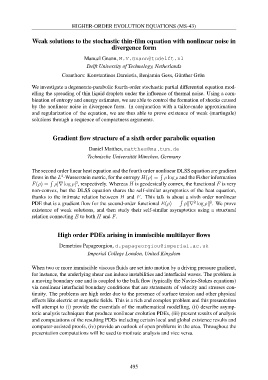Page 497 - 8th European Congress of Mathematics ∙ 20-26 June 2021 ∙ Portorož, Slovenia ∙ Book of Abstracts
P. 497
HIGHER-ORDER EVOLUTION EQUATIONS (MS-43)
Weak solutions to the stochastic thin-film equation with nonlinear noise in
divergence form
Manuel Gnann, M.V.Gnann@tudelft.nl
Delft University of Technology, Netherlands
Coauthors: Konstantinos Dareiotis, Benjamin Gess, Günther Grün
We investigate a degenerate-parabolic fourth-order stochastic partial differential equation mod-
elling the spreading of thin liquid droplets under the influence of thermal noise. Using a com-
bination of entropy and energy estimates, we are able to control the formation of shocks caused
by the nonlinear noise in divergence form. In conjunction with a tailor-made approximation
and regularization of the equation, we are thus able to prove existence of weak (martingale)
solutions through a sequence of compactness arguments.
Gradient flow structure of a sixth order parabolic equation
Daniel Matthes, matthes@ma.tum.de
Technische Universität München, Germany
The second order linear heat equation and the fourth order nonlinear DLSS equation are gradient
flows in the L2-Wasserstein metric, for the entropy H(ρ) = ρ log ρ and the Fisher information
F (ρ) = ρ|∇ log ρ|2, respectively. Whereas H is geodesically convex, the functional F is very
non-convex, but the DLSS equation shares the self-similar asymptotics of the heat equation,
thanks to the intimate relation between H and F . This talk is about a sixth order nonlinear
PDE that is a gradient flow for the second-order functional E(ρ) = ρ ∇2 log ρ 2. We prove
existence of weak solutions, and then study their self-similar asymptotics using a structural
relation connecting E to both H and F .
High order PDEs arising in immiscible multilayer flows
Demetrios Papageorgiou, d.papageorgiou@imperial.ac.uk
Imperial College London, United Kingdom
When two or more immiscible viscous fluids are set into motion by a driving pressure gradient,
for instance, the underlying shear can induce instabilities and interfacial waves. The problem is
a moving boundary one and is coupled to the bulk flow (typically the Navier-Stokes equations)
via nonlinear interfacial boundary conditions that are statements of velocity and stresses con-
tinuity. The problems are high order due to the presence of surface tension and other physical
effects like electric or magnetic fields. This is a rich and complex problem and this presentation
will attempt to (i) provide the essentials of the mathematical modelling, (ii) describe asymp-
totic analysis techniques that produce nonlinear evolution PDEs, (iii) present results of analysis
and computations of the resulting PDEs including certain local and global existence results and
computer-assisted proofs, (iv) provide an outlook of open problems in the area. Throughout the
presentation computations will be used to motivate analysis and vice versa.
495
Weak solutions to the stochastic thin-film equation with nonlinear noise in
divergence form
Manuel Gnann, M.V.Gnann@tudelft.nl
Delft University of Technology, Netherlands
Coauthors: Konstantinos Dareiotis, Benjamin Gess, Günther Grün
We investigate a degenerate-parabolic fourth-order stochastic partial differential equation mod-
elling the spreading of thin liquid droplets under the influence of thermal noise. Using a com-
bination of entropy and energy estimates, we are able to control the formation of shocks caused
by the nonlinear noise in divergence form. In conjunction with a tailor-made approximation
and regularization of the equation, we are thus able to prove existence of weak (martingale)
solutions through a sequence of compactness arguments.
Gradient flow structure of a sixth order parabolic equation
Daniel Matthes, matthes@ma.tum.de
Technische Universität München, Germany
The second order linear heat equation and the fourth order nonlinear DLSS equation are gradient
flows in the L2-Wasserstein metric, for the entropy H(ρ) = ρ log ρ and the Fisher information
F (ρ) = ρ|∇ log ρ|2, respectively. Whereas H is geodesically convex, the functional F is very
non-convex, but the DLSS equation shares the self-similar asymptotics of the heat equation,
thanks to the intimate relation between H and F . This talk is about a sixth order nonlinear
PDE that is a gradient flow for the second-order functional E(ρ) = ρ ∇2 log ρ 2. We prove
existence of weak solutions, and then study their self-similar asymptotics using a structural
relation connecting E to both H and F .
High order PDEs arising in immiscible multilayer flows
Demetrios Papageorgiou, d.papageorgiou@imperial.ac.uk
Imperial College London, United Kingdom
When two or more immiscible viscous fluids are set into motion by a driving pressure gradient,
for instance, the underlying shear can induce instabilities and interfacial waves. The problem is
a moving boundary one and is coupled to the bulk flow (typically the Navier-Stokes equations)
via nonlinear interfacial boundary conditions that are statements of velocity and stresses con-
tinuity. The problems are high order due to the presence of surface tension and other physical
effects like electric or magnetic fields. This is a rich and complex problem and this presentation
will attempt to (i) provide the essentials of the mathematical modelling, (ii) describe asymp-
totic analysis techniques that produce nonlinear evolution PDEs, (iii) present results of analysis
and computations of the resulting PDEs including certain local and global existence results and
computer-assisted proofs, (iv) provide an outlook of open problems in the area. Throughout the
presentation computations will be used to motivate analysis and vice versa.
495


